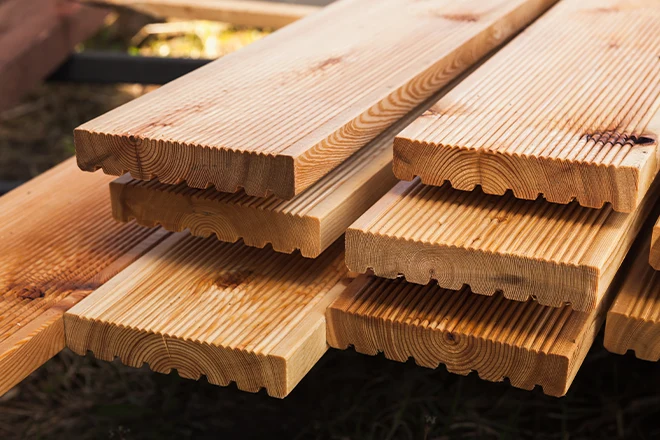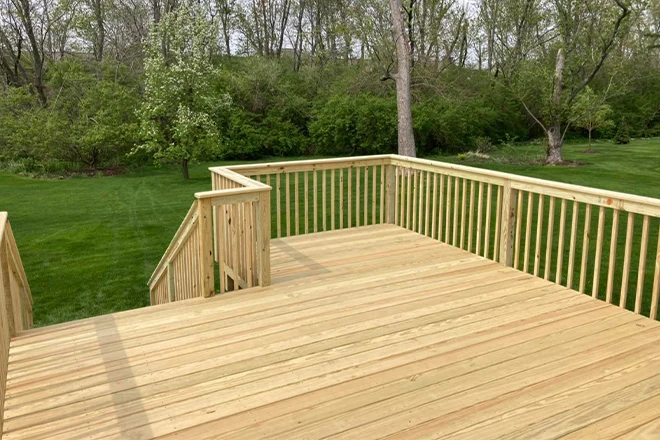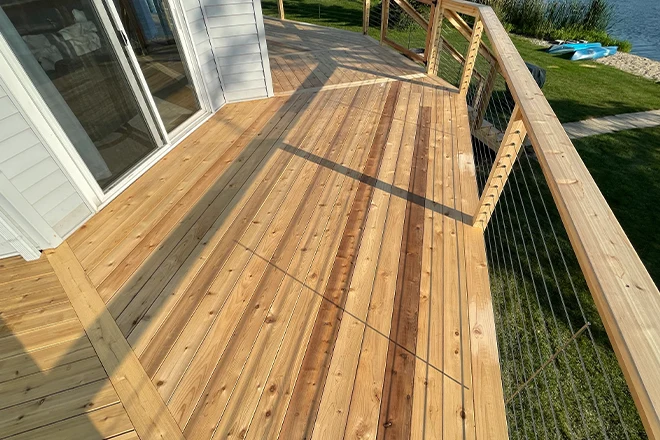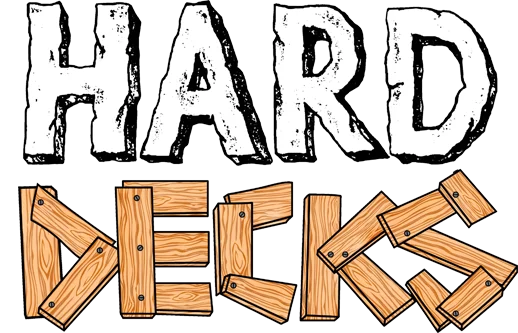
Discover the Best Wood Decking Types for Your Dream Deck
Are you thinking about adding a deck to your home but not sure which type of wood to choose? Do you want to know which decking material will give you the best bang for your buck?
In this post, you’ll learn about five different types of wood decking materials and the pros and cons of each.
By the end, you’ll be equipped with the knowledge to select the perfect wood for your Belvidere deck installation, ensuring it looks great and lasts for years to come.
What are the Best Types of Wood Decking?
- Pressure-Treated Wood: Affordable, durable, and chemically treated to resist rot, decay, and insects.
- Western Red Cedar: Naturally rot- and insect-resistant with a warm color but requires regular maintenance.
- Redwood: Premium wood with rich red tones and natural resistance to decay and insects.
- Mahogany: High-quality hardwood with rich color, fine grain, and excellent durability.
- Tropical Hardwoods (Ipe, Cumaru, Teak): Dense, highly durable, and insect-resistant, ideal for harsh outdoor conditions but more expensive.
Pressure-Treated Wood Decking

Pressure-treated wood is one of the most common decking materials.
This type of wood is usually pine or fir that has been treated with chemical preservatives to protect it from rot, decay, and insect damage. The process involves placing the wood in a pressurized tank where the preservatives are forced deep into the wood fibers.
Southern yellow pine is a popular choice for pressure-treated wood due to its strength and availability.
Advantages of Pressure-Treated Wood
Pressure-treated wood decking is known for its durability and resistance to decay and termites. It is also one of the most cost-effective decking materials available.
This type of wood decking is readily available in various grades and dimensions, making it a versatile option for different deck designs and budgets.
Disadvantages of Pressure-Treated Wood
Despite its benefits, pressure-treated wood has some drawbacks.
Initially, it has a greenish color that fades to a grayish hue over time. The wood contains chemical preservatives, which might be a concern for some homeowners.
Additionally, pressure-treated wood can warp and twist if not properly maintained.
Maintenance and Longevity
Maintaining a pressure-treated wood deck is relatively simple.
Regular cleaning with a mild soap or deck cleaner is typically all that is needed. However, it’s important to check for loose nails or screws periodically.
With proper care, a pressure-treated wood deck can last between 20 to 40 years.
Contact us to start building your treated wood deck.
Western Red Cedar Decking
Western red cedar is another of the best wooden decking types.
This wood type is naturally resistant to rot and insect damage thanks to its natural oils. The color of cedar varies from light brown to salmon pink, which gives it a unique and appealing appearance.
Advantages of Cedar Decking
One of the main advantages of cedar decking is its aesthetic appeal. The natural beauty of cedar can enhance the look of any outdoor deck.
Cedar is also stable and resistant to warping, making it a durable choice for decking.
Disadvantages of Cedar Decking
Cedar is a relatively soft wood, making it prone to dings and dents.
It also requires regular maintenance, including sealing and pressure washing, to keep it in good condition.
Maintenance and Longevity
Cedar decks need annual maintenance to preserve their appearance and longevity. This includes sealing the wood and possibly an annual power washing to remove dirt and debris.
With proper care, a cedar deck can last between 13 to 20 years.
Redwood Decking
Redwood is one of the premium types of wood decking materials, known for its striking color variations ranging from light red to dark reddish-brown.
This type of wood decking is often graded to indicate quality and appearance.
Common grades include Clear Heart, which is free of knots and defects, B-Grade, Construction Heart, and Construction Common. Each grade varies in terms of durability and aesthetic appeal, with Clear Heart being the highest quality.
Advantages of Redwood Decking
Redwood decking is highly resistant to decay and insect damage, making it an excellent option for outdoor decks in Illinois. The natural oils in redwood help preserve its integrity over time, offering a beautiful and durable solution for your decking project.
Additionally, the natural beauty of redwood enhances the aesthetic appeal of any outdoor living space.
Disadvantages of Redwood Decking
While redwood is a desirable decking material, it is softer than other hardwoods and can weather quickly if left untreated.
This wood type is also more expensive compared to pressure-treated wood and cedar, which might be a consideration for budget-conscious homeowners.
Maintenance and Longevity
To maintain its rich color and extend its lifespan, redwood decking requires routine maintenance. This includes applying a UV-blocking finish to protect against sun damage and regular cleaning to prevent mold and mildew buildup.
With proper care, a redwood deck can last between 20 and 30 years, making it a long-term investment in your home’s outdoor space.
Mahogany Decking
Mahogany is another of the top-tier wood decking types, prized for its rich, reddish-brown color and fine grain.
True mahogany, such as Honduran mahogany, is preferred for its superior durability and resistance to decay. Other mahogany species, like Philippine mahogany, are often marketed under the same name but may not offer the same level of performance.
Advantages of Mahogany Decking
One of the primary benefits of mahogany decking is its exceptional durability and resistance to decay and insect damage.
This hardwood is also highly stable, meaning it is less likely to warp or twist over time.
The rich color and grain patterns of mahogany add a touch of elegance to any deck, making it a popular decking material for homeowners seeking both beauty and functionality.
Disadvantages of Mahogany Decking
Not all types of mahogany are suitable for outdoor use, so it’s essential to choose true mahogany for your deck.
Mahogany is also more expensive than many other wood types, which can be a consideration for those on a tighter budget.
Maintenance and Longevity
Mahogany decking requires regular maintenance to preserve its color and longevity. This includes applying a UV-resistant finish and periodic cleaning.
With proper care, a mahogany deck can last up to 40 years, making it a durable and long-lasting option for your decking project.
Tropical Hardwood Decking (Ipe And Others)
Tropical hardwoods for decks, such as ipe, cumaru, and teak, are renowned for their exceptional durability and resistance to harsh outdoor conditions.
Ipe wood, in particular, is one of the hardest and most dense wood types available, making it highly resistant to insect damage and decay. These woods are sourced from tropical regions and are known for their rich color and unique grain patterns.
Advantages of Tropical Hardwood Decking
Tropical hardwood decking offers unparalleled durability and can last up to 75 years with proper care.
The dense nature of these woods makes them naturally resistant to insects and rot, reducing the need for chemical treatments.
Additionally, the rich, natural beauty of tropical hardwoods enhances the aesthetic appeal of any outdoor deck, making them a sought-after choice for premium decking projects.
Disadvantages of Tropical Hardwood Decking
The primary drawback of tropical hardwoods is their high cost. These woods are more expensive than other decking materials, which can be a significant investment for homeowners.
Also, the hardness of these woods can make them challenging to work with, requiring specialized tools and skills for installation.
Maintenance and Longevity
Tropical hardwood decks require regular maintenance to maintain their appearance and longevity.
This includes applying a clear, UV-blocking preservative every few years and routine cleaning to prevent dirt buildup.
Despite the maintenance, the investment in a tropical hardwood deck is often justified by its exceptional durability and long lifespan.
Discover the pros and cons of other decking materials.
Comparing Costs of the Types of Wood Decking Materials

Pressure-treated lumber is one of the most affordable decking materials available. The cost can vary depending on the grade and quality of the wood, but it generally offers excellent value for its durability and resistance to decay and termites.
Cedar is slightly more expensive than pressure-treated wood but is still considered one of the more affordable types of wood decking.
Redwood and mahogany are higher-end wood decking types, with costs reflecting their premium quality. Redwood decking, especially the Clear Heart grade, is known for its durability and natural beauty, making it a more expensive option. Mahogany, particularly true mahogany, also comes at a higher price due to its rich color, fine grain, and long lifespan.
Tropical hardwoods like ipe are among the most expensive wood decking materials. Their exceptional durability and resistance to harsh outdoor conditions justify the higher cost. While the initial investment is significant, the long-term benefits, including minimal maintenance and longevity, make exotic hardwoods a worthwhile option for those who can afford them.
Want to know more about the cost of wood decking in Belvidere, IL?
Maintenance and Care Tips for Different Wood Decking Types
Proper maintenance is essential to keep your wood deck looking its best and to extend its lifespan. Here are some maintenance and care tips for different types of wood decking materials.
General Maintenance Practices
Regular cleaning and inspection are crucial for all wood decks. Sweep away debris, leaves, and dirt to prevent mold and mildew growth. Use a mild soap or deck cleaner to wash the surface of your deck, and check for loose nails or screws to ensure safety.
Specific Care Instructions
Different types of wood decking materials require specific care routines.
- Pressure-Treated Wood: This type of deck wood requires occasional cleaning and inspection for signs of wear. Although it is treated to resist decay, it can still benefit from sealing to prolong its life.
- Cedar and Redwood: These woods should be sealed annually to maintain their natural color and prevent weathering. Pressure washing can help remove dirt and grime, but be cautious to avoid damaging the softwood fibers.
- Mahogany and Tropical Hardwoods: Apply a UV-resistant finish to these decks every few years to maintain their rich color and prevent sun damage. Regular cleaning is also essential to keep the surface free from dirt and debris.
Seasonal Maintenance Checklist
Adhering to a seasonal maintenance routine can help keep your deck in top condition year-round.
- Spring: Inspect your deck for any damage that might have occurred during winter. Clean the surface thoroughly and reapply the sealant if necessary.
- Summer: Perform regular cleaning to remove dirt and debris. Check for any signs of wear or damage and address them promptly.
- Fall: Prepare your deck for winter by giving it a final cleaning and applying a protective sealant. Remove any furniture or items that could cause moisture buildup.
Choosing the Best Wooden Decking for Your Needs
Selecting the best wood decking material for your project involves considering several factors, including budget, climate, aesthetic preferences, and maintenance commitment.
Budget Considerations
Your budget will significantly influence your choice of wood decking types. Pressure-treated wood is the most cost-effective option, while tropical hardwoods are the most expensive. Evaluate your long-term goals and decide if the initial investment in premium wood is worth the potential savings on maintenance and replacement costs.
Climate and Environmental Factors
The climate in Illinois can impact the performance and longevity of your deck. Choose one of the wood decking types that can withstand the local weather conditions. For example, cedar and redwood are naturally resistant to rot and insects, making them suitable for humid environments.
Aesthetic Preferences
Consider the appearance you want for your deck. Each type of wood offers a unique look, from the rich, dark tones of mahogany to the light, natural color of cedar. Think about how the decking material will complement your home’s exterior and your outdoor living space.
Do you want some great deck design ideas?
Usage and Traffic
If your deck will experience heavy foot traffic or support outdoor furniture, opt for a durable wood type like ipe or pressure-treated wood. These materials are less likely to dent or scratch compared to softer woods like cedar.
Maintenance Commitment
Be realistic about the amount of time and effort you can dedicate to maintaining your deck. Low maintenance options like tropical hardwoods or pressure-treated wood are ideal for busy homeowners who prefer a more hands-off approach.
FAQs About Wood Decking Types
What is the best wood for decking?
Ipe, cedar, and redwood are among the best wooden decking types known to last 20 years or more. While not the most budget-friendly options, their longevity makes them ideal for decks. Proper sealing and regular maintenance can further extend their lifespan.
What is the longest-lasting wood for a deck?
Ipe, a Brazilian hardwood, is the most durable choice for natural wood decks. Nearly maintenance-free, it lasts for decades due to its dense structure and natural preservatives. Ipe is highly resistant to rot, insects, and even fire.
Choose Hard Decks and get an Exceptional Deck
At Hard Decks, we specialize in creating stunning and durable wood decks that enhance your outdoor living space. Our expertise ensures that you get the best materials and craftsmanship for a deck that will stand the test of time.
Ready to transform your backyard? Fill out our contact form today, or give us a call to get started on your dream deck.
